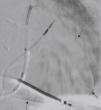A 79-year-old man, previously diagnosed with ischemic heart disease and valve disease, who had undergone coronary artery bypass grafting and aortic valve replacement, was referred for implantation of a cardiac resynchronization system with defibrillator (CRT-D). He was in NYHA functional class III under optimized medical therapy, with left ventricular ejection fraction of 25%, mean QRS of 160 ms, and left bundle branch block.
After the coronary sinus was accessed, venography showed the target lateral vein (Figure 1). The guide wire was introduced up to the distal portion of the vein and the left ventricular lead was advanced, but the proximal region of the vessel could not be crossed. It was decided to advance the guide wire from the lateral vein via a posterior collateral vessel up to the coronary sinus ostium (Figure 2). A snare system was introduced through a sheath via the left subclavian vein up to the atrium (Figure 3A) and the end of the guide wire was gradually pulled towards the skin surface. Thus, both ends of the guide wire were under the operator's control (Figure 3B) and the lead could be advanced to the desired position by pulling the guide wire (Figure 4). CRT parameters were satisfactory without diaphragmatic stimulation. There were no complications.
Correct positioning of the left ventricular lead is crucial to a favorable response to CRT, but venous anatomy often hinders this goal, and alternative and sometimes technically challenging approaches must be adopted to obtain the greatest clinical benefit, as described here.
Conflicts of interestThe authors have no conflicts of interest to declare.
Ethical disclosuresProtection of human and animal subjectsThe authors declare that no experiments were performed on humans or animals for this study.
Confidentiality of dataThe authors declare that no patient data appear in this article.
Right to privacy and informed consentThe authors declare that no patient data appear in this article.
Please cite this article as: Magalhães A, Menezes M, Cortez-Dias N, de Sousa J, Marques P. Utilização de sistema de extração Snare para implantação de eletrocateter ventricular esquerdo na ressincronização cardíaca. Rev Port Cardiol. 2015;34:221–222.












